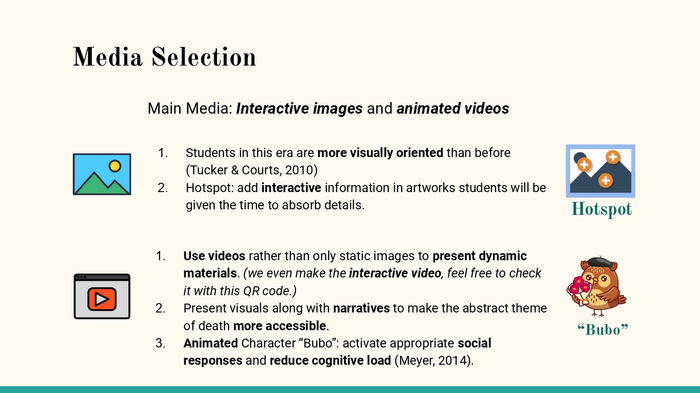Gina
Lai

A Theory-based Workshop for Middle Schoolers @NYU
theories
9
12
principles
8
supporting materials
Artful Passages
Background
Address the Crucial Aspect of Life Education
During our group project in the Cognitive Science course, we noticed a lack of adequate guidance on the subject of death among U.S. public school students. Enthusiastic about museums, we proposed using artworks from museums worldwide to address this vital aspect of life education for young learners.
First stage: Market Research
A Compare Analysis of Death Education Programs
We analyzed four death education programs, noting variations in target audiences, interactivity, emphasis on death education, and emotional aspects. These examples share theoretical applications and a lack of multimedia usage, highlighting the importance of prior knowledge. Our primary critique is the insufficient multimedia engagement, unclear chunking, and inadequate activities for motivation and metacognition.
Second stage: Design with Theories
Crafting Learning Concepts into Real-World Applications
Our proposal comprises four sections: Introduction, Lecture, Activity 1, and Activity 2, guiding learners through Bloom’s Taxonomy levels. In the Introduction, we use an elephant funeral video clip to prompt discussions and engage the senses. Students then express thoughts on death through flexible art creation, applying the Schema theory.
During the lecture, We made an 3-minute video that summarizes the similarities and differences of the concept of death in Medieval and Enlightenment era, incorporating six of the Cognitive Theory Multimedia Learning principles.
Activity 1 involves group work to compare artworks, categorize them, and complete an element chart. Motivation and Engagement strategies are applied, fostering competence and encouraging explanation within groups.
Activity 2 prompts learners to synthesize knowledge by creating new artwork based on the element chart. They critique peers' creations, engaging in Complex Cognition. The strategies involve positive emotional associations and supported drawing, encouraging improvement and deeper engagement with deconstructed elements from paintings.
Reflection
Learn to Outsource Tools
A significant lesson from this project was the identification of various educational supplementary tools available online. For instance, the utilization of the H5P platform for generating hotspot maps proved to be both accessible and cost-free, challenging my previous assumption that such functionality required expensive custom development. Additionally, our adoption of Canva for the creation of our lecture video garnered positive feedback during our formal class presentation.
User Narrative is Extremely Useful
We only realized the flaws in our plan when we started writing the user narrative, as the project did not require actual implementation. This exercise helped us understand our audience better and revealed the shortcomings in our design and process. What prior knowledge would they bring to the table? What do we aim for them to retain? It was a transformative experience as we were then able to reconsider the objectives of each section.


























